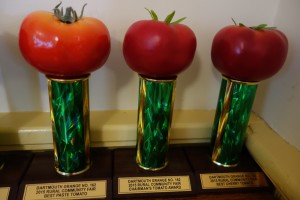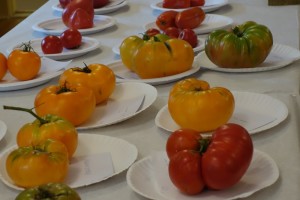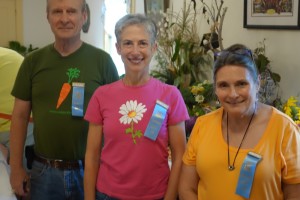Fall is the season for agricultural fairs. I remember attending the York Fair in Pennsylvania every September. What excited me then was spinning upside down on the Zipper ride and similarly dizzying effects from eating funnel cake coated with confectioner’s sugar. At this stage in life, I’m more fascinated by agricultural and horticultural exhibits and how fairs strengthen a sense of community, deepening awareness about local producers and crafts.
This fall I was invited to be a judge for the Heirloom Tomato Contest at the Dartmouth (Massachusetts) Grange Fair. Founded in 1888 as a nonprofit organization that advocates for rural America, the Grange hosts educational and social activities that foster grassroots activism and community service. There’s also a shared-use community kitchen. The big annual event is the fall fair, which began roughly when the Grange opened in the late 1800s.
The tomato contest became part of the fair in 2007. The seed was planted when families in the Slocum Corner area of Dartmouth started experimenting with growing heirloom tomatoes and wanted to help others discover that “there’s more than those red, round, tasteless ones that were the only option in stores at that time,” says Ned Newton, chairman and founder of the tomato event at the Dartmouth Grange. Newton’s research led him to information about an event hosted by the Massachusetts Department of Agriculture at Boston’s City Hall and a tomato fair in Santa Barbara, California. “It was so exciting that it would’ve made anyone want to start a tomato contest!”
This year, 34 entries vied for first place for heaviest tomato and best-of-category. Platefuls of tomatoes filled a long table inside the Grange. They were grouped by category. Many are named after the size and shape of fruits that they resemble, for example cherries, pears, plums, grapes, and currants.
Newton emphasized that we were to “judge the tomatoes, not the growers.” Each plate was labeled with the variety name and the entrant’s number (to conceal the grower’s identity). A committee member sliced open one tomato on each plate to reveal the color and consistency of the flesh. Contenders for heaviest tomato were set apart to be weighed. Our task as judges was to score each entry by taste (up to 20 points), and by color, size, and shape (up to 5 points max each), for a maximum total of 35 points.
We started with the smallest tomatoes and worked our way up in size. Tomatoes sold at most supermarkets tend to taste and look pretty much the same. But with heirloom tomatoes, there’s remarkable variety of flavors, colors, shapes, and sizes. Some are the traditional deep red, while others are purplish-black, lime green, or bright yellow. Flavors range from smooth and creamy to piquant.
I nibbled my way down the line, taking time to consider too each tomato’s appearance. My highest scores went to the Coyote Currant and Gardener’s Sweetheart (both sweet); the Green Doctor’s Forest (like honeydew melon); and the Polish Linguica (peppery and slightly garlicky). The Brandywines and Jersey Devils didn’t do much for me, although other judges scored them much higher.
Our scores were totaled and tallied. The overall winner was the Polish Linguica. It was also named the best paste tomato entrant. Other category winners were Brandywine Beefsteak, Coyote Currant, and Marglobe Salad. The heaviest tomato weighed in at 28 ounces, lower than other years. (Bigger ones were available but not yet ripe, which disqualified them from entry.)
After fulfilling my duties and, reluctantly, returning my “judge” badge, I had a chance to admire the other exhibits. The dahlias were spectacular, ranging from deep crimson to creamy pink. Floral arrangements were judged for artistic arrangement, horticultural perfection, and choice of containers. Other displays featured quilts, canned goods, baked goods, and other home crafts.
Shy alpacas, goats, and rabbits were on display outside the Grange hall, alongside demonstrations of rug braiding and cider pressing. Young exhibitors displayed collections of insects, seashells, and wildflowers. Across the street at Alderbrook Farm, smells of sweet hay and earthy dung, and sounds of squawking chickens roaming freely, are unmistakable signs of a real working farm. Bright sun reflected off the polished hoods of antique tractors. Alderbrook Farm, one of the area’s best local farms and open since 1898, has a menagerie of animals as well as an honor-system stand for its farm-fresh eggs, seasonal produce, and other treats.
The fair was capped off by a pie-eating contest. Normally I would’ve been gung-ho about entering, but my stomach was groaning from the weight of so many heirloom tomatoes. I developed a prize-winning stomachache (was it the tomatoes or the onion rings?). But I would jump at the chance to do it again. Maybe next year I’ll save room for pie.
Details:
The Dartmouth Grange is in historic Russells Mills Village at 1133 Fisher Road in Dartmouth, Mass. The fair is held in September. Website: www.DartmouthGrange.org.
Alderbrook Farm, owned by Allen and Nancy Manley, is at 1213 Russells Mills Rd, South Dartmouth, MA 02748 and open 4 am-5 pm daily.









